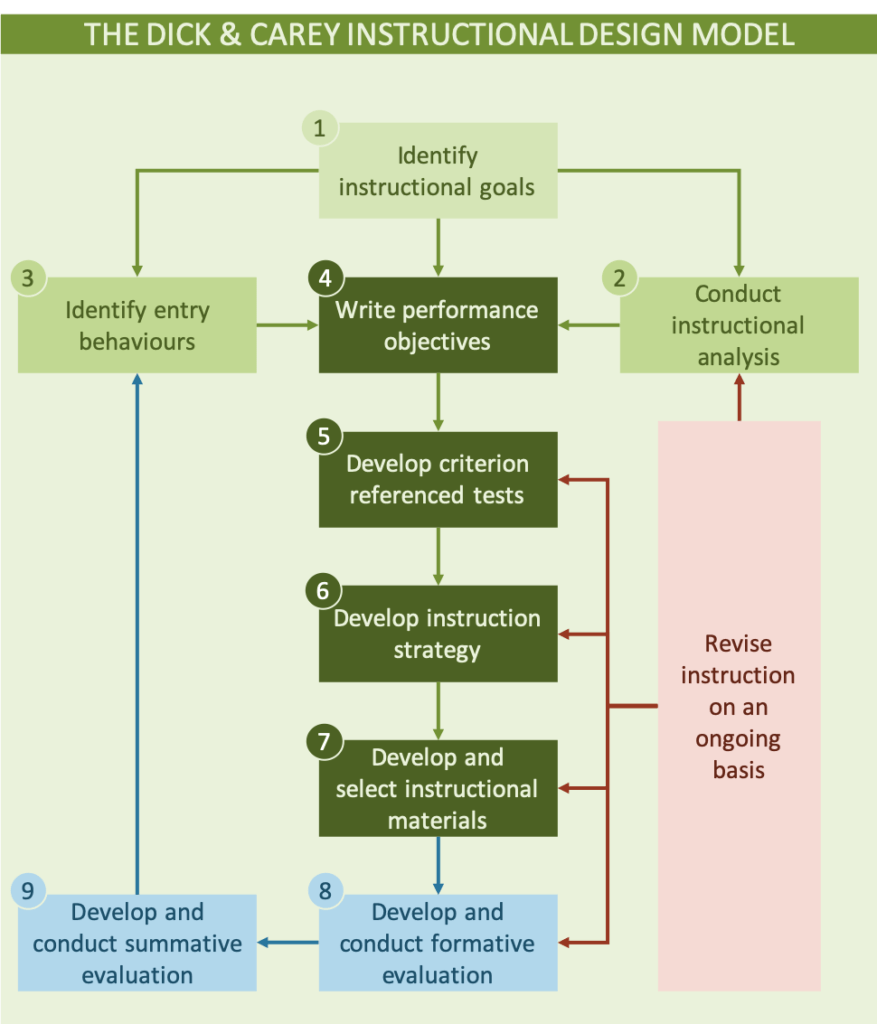The Dick & Carey instructional design model is a nine step process for planning training and development initiatives. It is more detailed than the ADDIE model, and provides for ongoing revision and iterative development.
Summary by The World of Work Project
Dick & Carey Instructional Design Model
The Dick & Carey instructional design model (AKA the Systems Approach Model) is a nine step process for planning and designing effective learning initiatives.
It includes all five stages of the ADDIE model, but adds further depth and structure as well. It also has more focus on design and less focus on implementation than the ADDIE model, builds in iterative development through ongoing revision of instruction.

1 – Identify instructional goals
Your instructional goals set out where you want to get to. In defining them you should align with your organization’s strategic goals, be clear on what learners will be able to do, or how they will behave, after your initiative has delivered and focus on real world skills and behaviors.
2 – Conduct instructional analysis
The second stage of the Dick and Carey Instructional Design Model is to conduct instructional analysis.
Your instructional analysis determines the current state of skills and knowledge in your learning population, and through this your gap to your goals. This can be assess through interviews, surveys, observation or different forms of testing depending on the nature of the skills.
3 – Identify entry behaviors
In addition to analyzing your learning population’s current level of knowledge, you also need to understand their behaviors, traits, levels of motivation and other factors that will affect their learning journey. This information will help you design appropriate learning methods.
4 – Write performance objectives
Learning objectives should be SMART and should lay out tasks and processes that must be mastered and how they will be assessed. These may be know as “SWBAT” in education (Student Will Be Able To).
5 – Develop criterion tests
To monitor and evidence both progress and effectiveness of instruction, you need to develop criterion specific tests. These should be of the right format and level for your learning population.
6 – Develop instruction strategy
Only once you know what your goals, current state, gap, objectives and testing approach are should you define your instructional strategy. It should reflect your analysis and use appropriate learning theories.
7 – Develop and select instructional materials
Materials, tools, exercises and delivery media should be decided once you have defined your learning strategy. These may include face to face, group based, facilitated or online learning materials.
8 – Develop and conduct formative evaluation
The penultimate stage of the the Dick and Carey Instructional Design Model is to develop and conduct formative evaluation.
Formative evaluation involves assessing how effectively you have formulated your learning initiative. This can be obtained through review, focus groups, testing of segments and piloting your learning program. Feedback obtained should be used to iterate the initiative.
9 – Develop and conduct summative evaluation
Summative evaluation takes place once you have delivered your initiative and is used to asses how effective it as has been. Are your participants satisfied with the program? Have knowledge and skills increased because of it? Has the business noticed any benefits due to it?
10 – Ongoing Revision
You should continually review and revise throughout your instructional design and development process. Regularly seeking feedback, testing outcomes and iterating through stages of your learning products will help you ensure you deliver the best possible outcomes.
Learning More
You might enjoy reading our posts on the ADDIE instructional design model and the Kemp instructional design model. We’ve also created a stub on Pedagogy and Andragogy.
The World of Work Project View
The Dick and Carey instructional design model is more comprehensive than the ADDIE model and addresses some of the risks associated with it.
The increased focus on goals, objectives and testing in this model help ensure that good outcomes are delivered. Similarly, the building in of ongoing revision helps instructional designers think about the development of their learning initiatives as an iterative and ongoing process.
Despite this model’s lack of detail in relation to implementation, it’s a good model and we recommend at least considering it when deciding how to approach a learning initiative in your organization.
How We Help Organizations
We provide leadership development programmes and consulting services to clients around the world to help them become high performing organizations that are great places to work. We receive great feedback, build meaningful and lasting relationships and provide reduced cost services where price is a barrier.
Learning more about who we are and what we do it easy: To hear from us, please join our mailing list. To ask about how we can help you or your organization, please contact us. To explore topics we care about, listen to our podcast. To attend a free seminar, please check out our eventbrite page.
We’re also considering creating a community for people interested in improving the world of work. If you’d like to be part of it, please contact us.
Sources and Feedback
This post is based on original content as created by Walter Dick, Lou Carey and James Carey. You can read more about the model in their 2004 book: “The Systematic Design of Instruction”.
We’re a small organization who know we make mistakes and want to improve them. Please contact us with any feedback you have on this post. We’ll usually reply within 72 hours.






